
Source: Results of own research
The use of Multicriteria Techniques for the selection of case studies in Sciences of the Administration
(*) José María De Luca; (**) Anabella De Luca; (***) Juan A. Adams (****) Guillermo A. Domínguez
(*)School of Economics
National University of Misiones
Posadas, Misiones Argentina
deluca@fce.unam.edu.ar
(**) School of Economics
National University of Misiones
Posadas, Misiones Argentina
anydeluca86@gmail.com
(***)School of Economics
National University of Misiones
Posadas, Misiones Argentina
jadams@fce.unam.edu.ar
(****) School of Economics
National University of Misiones
Posadas, Misiones Argentina
cpguillermodominguez@gmail.com
Reception Date: 04/25/2018 - Approval Date: 06/04/2018
ABSTRACT
This survey analyses, a ranking construction method respective to the teaching criteria content in learning cases of the Integrated Area III course.
It would for the authors have applied a multicriteria technique named Analytic Hierarchy Process which acronym is A. H. P.
As another application of this methodology, it has been achieved, by the reverse path, to designing new cases, from the importance given to the criteria previously assessed.
To collecting information, it has been performed in the 2016 course, a poll to the student population and also to the teachers.
It has been proved that a consensus between teachers and students, referred to the importance of the criteria selected to assessing the learning cases, so as the greater significance characteristics identified by both, to achieving the goals of the course developed.
KEYWORDS: University Education; Teaching Planning; Decision Theory; Analytic Hierarchy Process.
INTRODUCTION
The Degree in Business Administration taught at the Faculty of Economic Sciences of the National University of Misiones (Argentina) has, according to the plan of studies presented on its website , with a profile design of the graduate that ponders the leadership and the business capacity.
This aims to train professionals capable of facing changing socioeconomic contexts and uncertainty, which are the main characteristics in which companies in the region are immersed.
From the reading of the curricula it is clear that in their curricular reforms the creation of new integrating spaces of theoretical and practical knowledge, called Integrated Areas, is proposed as a novel contribution, and is one of the reasons for this investigation.
There is an abundant literature that analyses the need to integrate practical applications and theoretical knowledge in university education. One of the authors who agree with this method is Miguel Zabalza Beraza (2012) who justifies that the intermediate spaces of connection between the contents of the different disciplines allow the student to apply the theory that he knows to practical cases and thus build knowledge.
Karen Burrell and others (1997) analyze the curricular training of university students, reviewing the demand for the literature necessary for this purpose.
It is proven that students are able to think critically, self-motivated, and with independent thinking. This allows them to face their professional challenges and, in addition, they can conduct similar bibliographical searches according to their expectations.
Other authors such as Alice and David Kolb (2005) review styles and learning spaces, strengthening evidence-based learning. They also demonstrate the existence of an interface between the student's learning styles and the institutional setting where it is applied. Finally, this study proposes several proposals to strengthen learning based on experiences and suggests how to improve the institutional environment for this purpose through the development of institutional programs including evaluation of results, curricular development and strengthening of teacher training.
The teaching supported by qualitative case studies is reviewed by Robert Kozma and Ronald Anderson (2002) who claim to have identified pedagogical innovations in almost all the universities of the countries participating in the study, the most important being those that combine the use of qualitative techniques with quantitative.
Based on these concepts, the Integrated Areas have been created, which fulfill the task of knowledge link spaces, each located in a different year of study, the first of which corresponds to the second year of the career.
Integrated Area III is a subject that was created to fulfil the function of a nexus between theory and practice, that is, it has the function of getting students to apply the knowledge learned in other subjects throughout the career destined to the resolution of problems of Administration Sciences in companies simulated to the socio-economic reality of the region using the didactic strategy of case studies.
These cases are designed taking into account the most important curricular criteria identified by teachers.
The subject seeks students to solve problems that arise in companies in the region, conflict situations, learning to make managerial decisions and it takes place in the second semester of the fourth year.
With regard to the didactic strategy analysed, which is the case study, the author Díaz Barriga Arceo (2003) argues that using this type of strategy promotes skills of application and integration of knowledge, critical judgment, decision making and problem solving.
Other authors such as Cristina Martínez Carazo (2006) add that their importance is based on the fact that they are focused on practice. This enables the application of the knowledge acquired to specific situations, which allows the acquisition of skills and abilities related to the subject matter of study. He also states that the purpose of the case studies is to guide students on how they should act. They are strategies that develop useful skills for professional life.
The main problem that presents the creation of integrating spaces of disciplines, knowledge and different skills, in the teaching of Administration Sciences is to assign an order of priorities and importance to the multiple objectives coming from the subjects to be integrated, and that are intended, in a short time, achieve consolidate in the training of the future professional.
In order to provide a methodology that solves this question, the authors have studied the application of tools based on multicriteria techniques, commonly used in business decision making, for the assessment of the objectives of the Integrated Area III subject.
The importance of this research is that, while these techniques are in the business world applied by peers from the same organization (managers, technicians or project managers), they will now be used by teachers responsible for the administration of the subject, observing the criteria to be applied and objectives to achieve, and students participating in it that wield the topics of interest for their professional future.
In addition, while companies seek to solve problems of resource allocation, choice of projects, investments, etc., in this case will aim to improve the design of pedagogical methodologies taking into account also the opinion of students.
The reason for knowing the importance that they assign to the criteria and cases is due to the need to create significant pedagogical practices. This means that, for there to be learning, cases must be adjusted to the student's needs, interest (emotion) and context (real problems). In this way, he relates the new with what he already knows (Rodríguez Meléndez, 2016).
Multicriteria techniques have already been applied in university education with different objectives, as indicated by Edwin Tarapuez (2016), who identified and valued the importance of the factors that influence the business intention of university students in a region of Colombia.
This author argues that there is a great discrepancy between the objectives of the curricula in the Administration Sciences and the expectations expressed by the students of these careers in the Department of Quindio (Colombia).
To discover the order of priority or importance that students and teachers assign to the curricular criteria and cases already worked on, the use of a methodology based on multicriteria analysis techniques such as the Analytical Hierarchical Process (PJA) applied by Samuel Lee (2015) is proposed in the selection of training techniques.
It is pertinent to explain which the curricular criteria are selected by the faculty and that are part of the program of the analysed subject, and supported in them, the design of the cases to be worked is obtained.
The selection of the criteria has its origin in the academic and professional training of the faculty of the subject. Their experiences and knowledge of the business world of the region have allowed them to select a group of them from a list offered for their election.
Then, the consolidation process of the chosen criteria was carried out in a smaller group, eliminating similarities and repetitions.
This way, the fundamental criteria that are listed in the following table were obtained, and that in the development of the work they will be used with their denomination.
Table N° 1. Criteria Used to assessing of the Studies Cases

Source: Results of own research
The development process that it has been followed in the research was that, previous to the teaching of the course, the faculty team had a meeting and they made a criteria list like it was formerly explained for, later assign importance weights through the A.H.P. technique with their participation.
Later, at the end of the course it has performed the student and participants consult about it and it has been explained the A. H. P. technique again for finally processing the information and detailing the experience.
DEVELOPMENT
Basis of the Choice of Technique
The null hypothesis raised in this research is that the importance that teachers have given to the criteria used for the design of cases, coincides with that assigned by students through the contents of the cases studied.
The objectives set out in the present work are: a) To compare the order and importance of the cases given in Integrated Area III by the students and the curricular criteria used in their designs by the teachers b) To identify the order of importance of the curricular criteria that determine the profile of the cases according to the weighting of the teachers and compare them with the inclinations of the students in the cases that said criteria have been used c) Know the characteristics or profile that future cases should have to be selected based on the experience obtained by the multicriteria technique.
To fulfill the objectives, a multicriteria decision analysis technique has been chosen.
The reason of the election of it, which name in English is Multi Criteria Decision Analysis and its acronym in this language is MCDA, is because, as Vince Belton and Thomas Stewart (2002) hold, it includes concepts, methods and techniques that they help to individuals or groups to organizing and ordering better the information. Besides, it involves several points of view and multiple interest’s groups, to taking decisions in a safer way of choosing the best action course possible. In this case, this methodology has taken into account the interest lining up from both actors (faculties and students) about the curricular criteria and the course cases in fact.
The different MCDA techniques and concepts has been widely already worked in Operation Research field, and for this survey it has been decided to use A. H. P.
The choice of this method of analysis developed by Thomas Saaty can be applied to establish an order of importance of a set of categories, in this case the curricular criteria, in front of a problem, which is the best profile for the design of case studies where both interests converge, as the author Edwin Tarapuez (2015) argues in his research on criteria that influence the creation of the entrepreneur profile of students in a Colombian region.
Through this technique we seek to prioritize on the part of teachers, the criteria of the subject as well as prioritize on the part of students, the cases worked. Aposteriori, analyse the degree of importance that each criterion has had in them.
Data Collection
To collect the data to be analysed with this method, two types of questionnaires have been used, one for teachers based on comparison of pairs of criteria, and another for students where an absolute scale of the cases performed by them has been applied, according to the criteria observed.
As suggested by Roberto Hernández Sampieri, et al. (2006), it has been decided to apply different forms since, in the case of teachers, they consisted of a set of questions regarding one or more variables to be measured, in this case they were the criteria that determine the subject and the design of the study cases.
While for the students, the information collected has been the measurement of the cases themselves, oriented according to the predefined criteria.
Although the A. H. P. has been designed to using pairwise comparison David Opydo (2014) suggests that, a certain circumstance is suitable to using an scale fitted to the diversity of the elements to measuring.
The student questionnaire, has been designed using scale question continuous classification to measuring the interviewer opinion about the cases worked based in the curriculum criteria.
In the study performed has been participated the whole faculty team group of the subject and the whole twelve students that they studying integrated Area III.
Data Analysis
/Before analyzing the data collected it is necessary to explain the criteria or curricular axis used for the team faculty.
The Agreement Models to Taking Decision Group of the A.H.P.
The research Yoo Dong et al. (2010) has been explained the agreement models in the decision taking and they assert that generally, the preference relations are accepted to be using in creating group decision taking and according to the way of the elements in the preference relations, they exist linguistic numerical preference relations or numerical preference relations.
The linguistic variables are qualitative, and they differ from the numerical in that its values are not numeric but words or sentences, therefore they are accurate less that the number.
Generally, the linguistic variables serve to supply a characterization approximated of the elements or phenomena when it is very complex.
The same authors assert that, the group decisions taking problems and solved through preference relations, are being confronted applying two different process, and in them are using linguistic variables; the selection model and the agreement model.
The selection model lies in the aggregate individual preference in of the group member through an approach that it embodies weights according the importance of the judge of the member and the obtaining of the collective preferences.
The agreement model allows to knowing what alignment grade have the judge of the member, and for that, is important in the decision group.
It is defined how much it is near to the total and unanimous agreement of the member according to the possible alternatives.
Thomas Saaty (1989) asserts that like the total and absolute agreement of the member is one of the possibilities to achieve, has been needed to establishing a measure of the consistency model, that it is used for the differences between the member and it is a key measure of the agreement models.
This measure contains two appearances to consider:
When it can to consider the individual decision as consistent, named individual consistency measure.
When it can to consider the group decision as consistent, named group consistency measure.
The agreement models are group decision taking aid tools since they help to achieve agreement values according the consistency measure obtained.
The Agreement models Applied to the Judges Emitted from the Faculties
With the professors forms and its posteriori conversion to the scale suggested by Thomas Saaty and Luis Vargas (2001) showed in Table N° 2, It could made the preference matrix of each one of them, that they are square matrix, where rows and columns contain the same criteria to confront by pairs (the criteria I placed in row I vs criteria j placed in column j).
It can be inferred from the scale of Table N° 2 that the values of the diagonal of the matrix will be unit values.
It can detach of the scale of the Table N° 2 that the diagonal matrix values will be unitary value.
Table N° 2. Saaty Fundamental Scale for Pairwise Comparisons
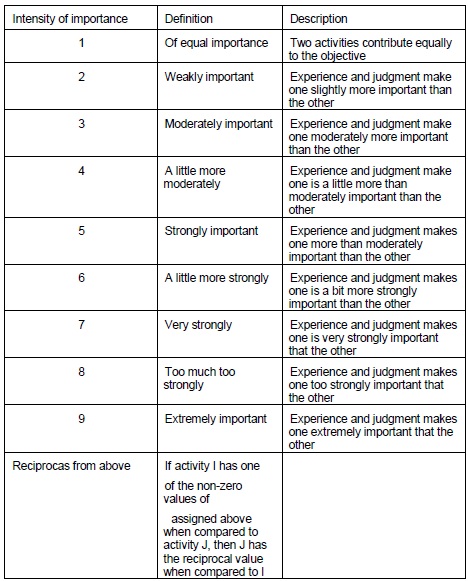
Source: SAATY & VARGAS, Models, Methods, Concepts and Applications of the Analytic Hierarchy Process, 2001
The Saaty scale does not contain decimals values, only integer one, but it does not prevent to generate decimal values.
As Marcos Dos Santos et al (2017) sustains, it is not recommended to replace the Saaty scale for any other like Likert, since not always it can achieve similar values of consistency index from the emitted judges by the manager using both scales.
The consistency index shows the coherence in the values paired decided by the manager to building the Comparisons Matrix.
The Comparison is suitable to performing not only in the integer multiple values relation, how many times an element is most important than the other, but also, if it is necessary, to assigning a decimal value to such relation.
It is accepted to perform the comparison and assignement in a direct way of the decimal value, if the management is qualified for this process.
The eigenvectors corresponding to the principal eigenvalues of the preference matrices of the criteria according to the teachers' judgments are indicated in Table N° 3.
The eigenvalues respective to the main eigenvalues of the criteria preference matrix according the professors judges are showed in Table N° 3.
In that table, it can be seen the importance that each professor has granted to each criteria and then the criteria mean value, respecting the total of the professors.
Table Nº 3. Criteria Autovectors and Mean Values
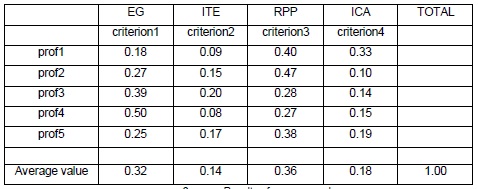
Source: Results of own research
Analysis and Interpretation of Priority Weights Criteria Obtained
The Table 3 shows that, for example, for the professor 1, the criteria WG (0.18) has the double of the value than ITE (0.09).
From the relationship between both values, it can be obtained the importance that both have in the contribution to the Integer Area III student academic training for the professor in fact.
It can be estimated that if well both contribute to the course goals, EG criteria contributes the double for such professor, he gives more priority to the Manager Training in the case election than the importance In Team Work.
Integer Area III is a course that it points to the graduate future formation, and it is focused specially to the job positions at the beginning will be operational level, for very fast accomplish manager rols.
The named table shows the discrepancy in values between faculties, while that for professors 1.2 and 5, RPP (Reality Grade of the Case) is the criteria of maximum course goal contribution, for professor 4 is EG (Management training) is the greater importance since for this professor, this criterion contributes with the halve of the whole contribution to the education in the course, at equal to the professor 3.
In other words, for the three first faculties the cases must show a reality high degree in real situations or in simulated ones. It can think that some of the reasons could be that those professors that they have given greater weight to this criterion are professionals with s lot of management experience, and for the region still has more importance the practical experience than the theory.
It also can suppose that for them the student should be present a training that it put nearer to the real world once he ends theirs studies.
While that for the other two professors, the management trainee is priority, in other words, the cases could give to the students the possibility to apply management tools.
It could estimate that teachers give priority to the decision taking tools trainee because their management experience or outward consulting.
It also could explain this leading to the values given by such professors, that the regional firms are principally SME (small and medium enterprise), where it privileges the personnel skill and problems solving capacity applying practical knowledge than the academicals education.
Respect to the minimum, as well criteria ITE as ICA they are to the faculties the criteria that less importance have. At the time to design the cases it does matter less if these make possible the team job behavior development so like also if the cases accomplish with the knowledge integration criteria.
In reference to this last criterion, ICA, it has the assumption for the teachers that the student academicals education before Integer Area III had been created was unfinished to letting working with the cases and for this reason the same teachers propose cases using new tools and concepts.
Related to the minimum values assigned from the teachers to the criteria, it can observe that, in the larger part refer to ITE. This could think that the little importance to such criterion because in the regional SME, it strengths the individual values and not in groups.
Probably the decision to setting up as case dynamic resolution, the group team, has been, for teaching activity organizations ways, where the teachers has made an assumption that team work and work in group are synonym, acknowledging the differences between both of them, because in the first, everybody decide in a collaborative manner about the same matter and in the second each member focuses in a piece of it.
The AHP used in a Decision Group and its Importance
Like Walther Pedrycz y Michael Song (2011) explain, when AHP is applied to decision taking in a group manner it must achieve the adding up and integration of the individual criteria weights to achieve a unique criterion for the whole group, named Criteria Weight Mixed and Integrated, in Spanish the acronym is AIPC.
The formula used by the ![]()
Where:
 = Priority weight of person k in reference to the criteria i.
= Priority weight of person k in reference to the criteria i.
![]() = weight of person k in the group, in this case it has been considered similar weight to all professors.
= weight of person k in the group, in this case it has been considered similar weight to all professors.
When the AIPC take a null value, it achieves the whole consensus, it means that the discrepancy between the decision takers are zero. It accepts that for a number of members are greaters than 4 is accepted a value of 0.37.
In the case of the professors consensus level in reference to the criteria importance achieved a value of 0.0003, value very little that it means is accepted the group agreement.
Student Case Assesment According to the Criteria
The cases studied in class have been:
Case 1: Interview to a manager. The students interview a person that has a position as manager, that it means manager/entrepreneur of a firm to seeking about labor function, professional subject.
Case 2: Project Management (financial types). The students had that seeking financial programs through a Production Ministry web page choose one of them, explain and looking an example for the application in a firm.
Case 3: Looking at the service industry. It has been given to the student an example of a tourism real firm where in such case, it tells the problem that the firm has. The student worked with the case based in quality management tools named as Best Practices, where they had to choose one of them, develop and apply such tools in a problem of the example, looking for a solution. Here the learnt about service industry management and a approach to the quality management.
Case 4: Industrial Sector Analysis and Productive. The students choose a production sector that it not be wood, yerba mate, tobacco and tea like a condition. With the proposal to knowing new productive sector had to search the industry chosen (value chain, customers, productive process) looking for regional firms that it focused in it.
Case 5: Final Assignment firm Diagnosis. The student chose a local firm and then to visit and interview in reference performed a diagnosis using a new tool, Likert scale, and they determine the current/real firm and offer a solution.
To this analysis it has been interview the students to weight (from one to ten, sice one the minor value and ten the major) the five cases worked in base to the criteria of the course (RPP, EG, ICA, ITE).
From this poll, and then to make the calculus to getting the eigenvectors in reference to the main eigenvalues, and they had a mean by the weights of the criteria obtained of the judgement of the professors, they achieved to the following tables. The table 4 shows the case ranking according the importance for the student.
Table N° 4. General Ranking of the Cases According to the Consensus of the Students
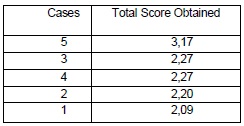
Source: Results of own research
From this table it can possible to deducing that the case 5 firm diagnosis was the case of greater importance to the students. It assumes that like they learn a new tool and they visit a firm for then solve a problem through this tool, such knowledge learnt in the case were the most significance that they have.
In the same way. The case 3 Look to the service and the case 4 Industrial and Productive Sector Review got the second place in importance, also by similar reason. The Case 3 was a new topic, where through new tools the students had to learn and apply to real problem seeking solutions. Instead of this, the case 4, although they have been working with productive industry, because they are ready to search the industry chosen whole unknown for them.
While the least relevance case was the case 1, Interview to the manager and case 2 project management. In the case 1 it is possible to suppose that, although the case implied an interaction with the managers through interviews, because it had not to applying any tools to solve problems did not mean of great importance for the students and so its value of the case least importance. Instead, the case 2 got the fourth position in the ranking and although the students learnt about current financial tools, as it was not required to them any suggestion about real firm, it was not of much interest.
In others words, those cases where the students learn new tools and demand the methods / tools / knowledges application to real problem solve are the cases greater weights they have.
On the other hand, in the following graphs show the weighted balanced that each criterion had according to the cases studied 2.
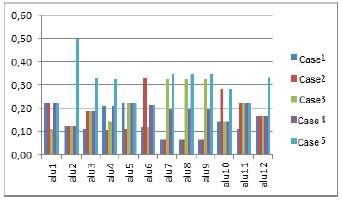
Graph N° 1. Comparative Analysis of Criterion EG1
Source: Results of own research
It is possible notice that in the cases where this criterion has greater significance was in the case 5, for 8 from 12 students in the survey (more than .20). It could think that, because the question of the case, Firm diagnosis, the management training was a criterion that weighted balanced more in this case for the most of them than in the others four cases worked. Even it is observed that in the case 3, a looking to the services, similar to the case 2 Project Management and case 4 Industrial Sector Analysis and Productive, it also this criterion was significative but a little minority.
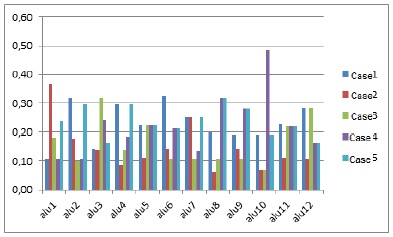
Graph N° 2. Comparative Analysis of Criterion ITE2
Source: Results of own research
For this criterion, it is observed that in the majority of the cases studied, it was important for the students. In other words, the team task was necessary for the solution and development of the cases. It could think that the students prefer the task in groups for some cases as case 5 or case 1, where had to confront to the reality, come out from the class, and for the rest of the cases is not much relevance as case 2.
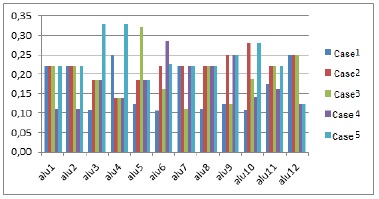
Graph N° 3. Comparative Analysis of Criterion RPP3
Source: Results of own research
For this criterion it can analyze that for the five cases studied was significative for the all twelve students. Really, in some cases more than others one, for example for the student 8 was an important criterion for all the cases but for the case 1, interview to a manager, while than for the others did it. Finally, it could achieve to the conclusion that the criterion Reality Degree for the professional practice (RPP) is crucial to formulate study case in the subject.
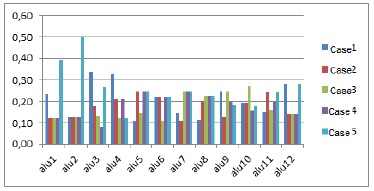
Graph N° 4. Comparative Analysis of Criterion ICA4
Source: Results of own research
Similar to the formerly cases, this criterion was important to the students in different cases, with a weighted balance more time greater than 0.20 shows that for the total inquired knowledge learnt in other courses Integration is the great relevance for designing of the cases.
CONCLUSION
Ricki Lewis (1992) has checked the study material selection process and textbooks in American colleges, identifying in almost all the situations books to checking overflow problem, little time for decision taking and many confronted criteria for exacts science subjects.
The books search that they exhibit quality in all the main criteria but not in some of them, has been the American faculty determinant profile in the bargaining with publishers and universities bookstores.
In this way, yearly, the professor focuses all the class activity in only one author and not in many, giving up academic quality by student single text comprehension.
Similar conclusion has achieved this survey about Integrated Area III, the student and professors behavior.
To the professors, the five agree the most relevance criterion is RPP (Reality Degree of the case).
To the students, although all criteria were important according to the case studied, it is noticed the difference in the discrepancy scale observed. It means that those criteria where the percentage is higher than 0.50 and that where the students, totally agree in similar values.
Therefore, it checkup that although for each student all the criteria are important, the criterion RPP is the grater agreement and importance in all the cases studied, situation that it agrees with professor analysis.
With the issue of the case studied, the students agree in that the mos relevance case has been case 5 Final Assignment firm Diagnosis, in that had to visit a firm, perform interview and remarks. Using a new tool performed the firm chosen diagnosis. Besides in such case the criteria that it had the most hierarchy was the criterion RPP.
Based to the setting up it can be assert that for this case, the chosen criterion as the most relevance for faculties agree, again with the students.
But it is necessary to do a stand in that for the totally of the students the criteria Importance of the performance of the team task (ITE) and knowledge learnt in other courses Integration (ICA) also are criteria of importance, instead, for the professors were both, the least relevance had. Following the answer of the cases, if it forces to looking information for or collecting data out of mass media, the team task has more relevance than in where the students solve the cases in class. And for the criterion knowledge learnt in other courses Integration, the teachers did not consider as a criterion with great weight but for the students Cn integrate through a solving of the case, issues learnt in linked subjects formerly as Management and Financial Accounting, Strategic Management, so on is the sum importance and interested in theirs trainee. Like it has been possible to observe in the case 5, 4 and 2.
Therefore, based to the analyzed it can propose that the future cases to developing must have in mind not only the professor goodwill but also the student opinion since they fix the knowledge when in the learning process interve the emotion (interest and motivation).
If the course Integer Area III was created exclusively to be a link, an integration between the theory that they are going studying and learning to apply at the practical issue, the study case that they must design have that looking the fuse up and motivators of the student interest.
When more similarity to the reality is the case, when more be the interaction between the student in the real world can solve the case set, like so greater the application of the knowledge learnt in other course, besides the apprentice in the fitness studying with the rest of the students to develop management tools, greater will be the interest of them and greater the building of knowledge (taking decision, problem solving, critical judgement, so on).
As conclusion it observes that the professors must create similar problems at the case 5, case 3 and case 4 looking in them for what the four criteria be the same weighted balanced.
Notes
1. www.fce.unam.edu.ar\carreras\administracion
2. Such graphs were obtained of the process and data analysis.
BIBLIOGRAPHCIAL ABSTRACT
Please refer to articles Spanish Biographical abstract.
REFERENCES
Please refer to articles in Spanish Bibliography.